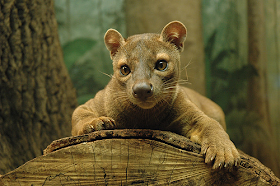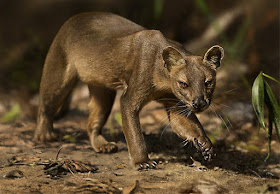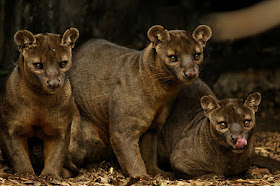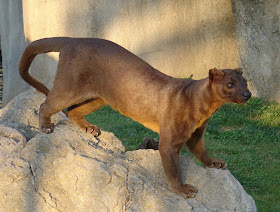Sunday, July 26, 2015
Fossa
Fossa Classification and Evolution
The Fossa is a medium-sized carnivore that is found exclusively on the island of Madagascar. The Fossa belongs to the Malagasy Carnivores group which are thought to have descended from Mongoose-like ancestors that arrived on Madagascar from Africa up to 24 million years ago. The Fossa is not only one of the most ancient of the eight species found on the island but it is also the largest, meaning that the Fossa is Madagascar's largest mammalian predator. However, due to the cat-like appearance of the Fossa it was believed to be a primitive species of feline until recently. Sadly like a number of the unique animal species found in Madagascar today though, the Fossa is incredibly rare and is now considered to be endangered in it's natural habitat primarily due to habitat loss.
Fossa Anatomy and Appearance
The Fossa is the largest land predator on the island of Madagascar with some individuals growing to nearly two meters in length from their snout to the tip of their long and slender tail. The tail of the Fossa is around the same length as it's body and plays a crucial role in helping the animal to balance whilst it is leaping through the trees. The Fossa has short but dense red to dark brown fur and a small cat-like head and a dog-like snout, with large forward facing eyes and small, rounded ears. Despite being related to Mongooses, the Fossa remarkably has a number of feline features including curved, retractable claws and slightly webbed feet which both help the Fossa when it is moving about amongst the branches.
Fossa Distribution and Habitat
Like the majority of the animal and plant species that are found on the island of Madagascar, the Fossa is found nowhere else on Earth. They rely on dense, forested areas where there is not only an ample food source but also plenty of space where the Fossa can establish it's large territory. Historically, Fossas would have been found in the forest and woodland areas across the island from coastal lowlands to mountainous regions, but are today restricted to a tiny portion of their once vast natural range due to extensive deforestation throughout Madagascar. Growing Human settlements have also severely affected Madagascar's Fossa populations as they are often hunted by farmers who fear for their livestock.
Fossa Behaviour and Lifestyle
The Fossa is a solitary and nocturnal mammal that patrols territories as large as four square kilometres and marks their presence with scent released from their large anal gland. The Fossa spends the vast majority of it's life high in the trees but is known to both move about and hunt on the ground as well. They are incredibly agile at both climbing and leaping, which is greatly helped by their long and slender tail and the fact that they move about on the flat soles of their feet means that they have more balance and stability when landing precariously on branches. Although the Fossa is largely nocturnal, they are known to also hunt during the day particularly when there is a lack of food but generally spend the daylight hours resting in a hollow tree, cave or an abandoned termite mound.
Fossa Reproduction and Life Cycles
Like many solitary carnivores, Fossas only come together to mate during the breeding season in September and October. After a gestation period that lasts for around three months, the female Fossa gives birth to usually two cubs that are very underdeveloped at birth and do not open their eyes until they are between two and three weeks old. The young are cared for by their mother and begin to eat solid foods by the time they are 12 weeks old, although they are not weaned for another month. Young Fossas take almost two years to grow to their adult size and then another two until they are able to reproduce themselves. They can live for up to 17 years although many reach much younger ages.
Fossa Diet and Prey
The Fossa is the largest carnivorous mammal on Madagascar and therefore survives by only eating other animals in the surrounding forest. The Fossa has evolved perfectly to the hunting and consumption of Lemurs and in fact, more than half of the Fossa's diet is comprised of them. They will also eat Lizards, Frogs, Rodents, Birds and Reptiles to supplement their diet along with small domestic animal such as pigs and poultry. Hunting under the cover of night means that the dark coat of the Fossa is perfectly camouflaged into the dense surrounding forest so they are able to stalk their prey silently in the trees before leaping powerfully to capture it. The retractable claws of the Fossa means that they are always at their sharpest for catching prey as they are not blunted by being constantly walked on.
Fossa Predators and Threats
Due to the fact that the Fossa is the largest natural predator in Madagascar, it has no predators itself (with the rare exception of being snapped up by a stray Crocodile). Humans pose the biggest threat to the Fossa as they have not only hunted them in fear of their livestock but have also completely decimated 90% of the Fossa's once vast natural range. Deforestation for both the logging of the rare tropical timber and also to clear land for agriculture has led to enormous declines in the wild population numbers. Due to the fact that Fossas not only require large solitary home ranges but they are also relatively slow at developing it is thought that numbers will continue to fall.
Fossa Interesting Facts and Features
The Fossa tends to measure around a metre long with the same length tail on top of that but, in recent years fossils of the now extinct Giant Fossa has been uncovered in the jungles of Madagascar, with the biggest Giant Fossa fossil measured nearly six meters in length and was thought to have weighed around 17 kg! The Fossa is well known for its fierce and dominant approach to hunting as it is extremely rare that it's intended prey will successfully escape. The Fossa can run unbelievably quickly and added to it's incredible agility in the tree tops, once a meal has been spotted the Fossa is very adept at then catching it.
Fossa Relationship with Humans
When early explorers first arrived on Madagascar there would have been the most incredible array of unique fauna and flora, much of which is now extinct today. Since their arrival Humans have exploited one of the world's largest islands leaving just 10% of the tropical forest cover that would have historically stretched across the country. Land clearance for agriculture such as palm oil plantations and deforestation of the unique tropical trees has led to drastic declines in the population numbers of numerous species, including the elusive Fossa. They are also hunted by farmers who want to protect their livestock and also by some who (unfairly) believe that they are of danger to people.
Fossa Conservation Status and Life Today
Today, the Fossa is listed by the IUCN as being an Endangered animal species and therefore one that is at risk of becoming extinct in it's natural environment in the near future. Although national parks and reserves do exist on the island, none are large enough to ensure that a decent sized Fossa population can survive as each individual requires a relatively large territory and there is simply too much competition. There are thought to be less than 2,500 Fossa individuals left in the wild of Madagascar.





No comments:
Post a Comment